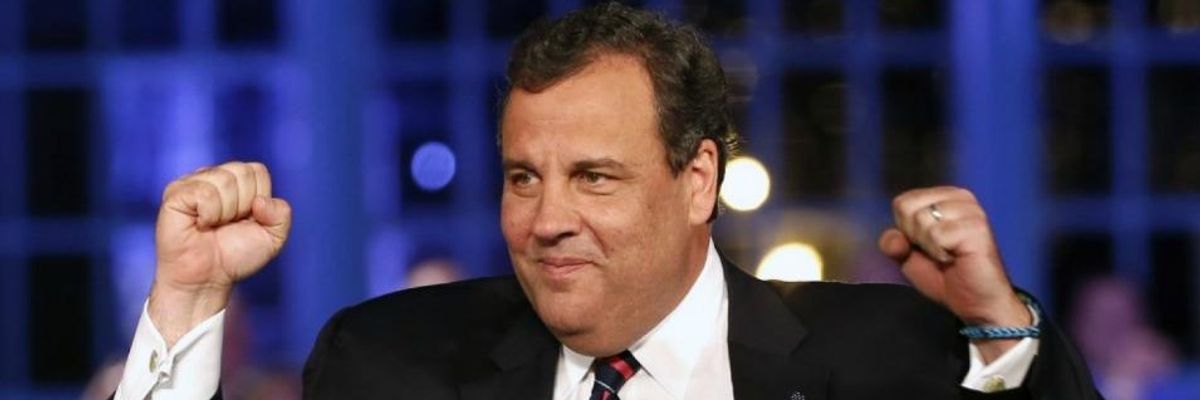Here's a question to ask New Jersey Gov. Chris Christie the next time he appears at a public event: "Why is it in your state the top 1 percent of income earners pay state taxes at a rate that is on average 28 percent less than what middle-income earners pay?"
Then watch the fireworks. You might even get a "sit down and shut up" out of him for having the nerve to lay this fact in front of him.
Then try a similar question of former Texas Gov. Rick Perry, who, like Christie, is considering a run for president in 2016. There the discrepancy is far worse - the top 1 percent only pay taxes at one-third the rate of the middle 20 percent of taxpayers.
In fact, the story is pretty much the same in conservative state after conservative state, whether it's Florida under Gov. Rick Scott or Kansas under Gov. Sam Brownback. In fact, according to a set of studies released today by the Keystone Research Center and Good Jobs First, "Across all 50 states, the highest-income one percent pay a significantly lower percentage of their income in state and local taxes than those in the middle of the income distribution - an average of 5.4 versus 9.5 percent, respectively."
This is after a set of elections that left Republicans with majority control of 30 state legislatures. (New Jersey is not one of those, but Christie boasts of his ability to get his policies enacted by the Democratic majority there.)
The report points out that if the top 1 percent paid the same percentage of their income in state and local taxes as the do the middle 20 percent, states would collect an additional $88.5 billion per year. Extend that principle to the top 20 percent, so they are paying the same rate as the middle 20 percent, and states and localities would have an additional $200 billion in revenue.
That would make a big difference in New Jersey, where one study of state fiscal conditions says the state is facing a fiscal 2015 deficit of $1.6 billion. Correcting the state's upside-down tax policies would wipe out that deficit and leave the state with a small surplus, their New Jersey report said.
Kansas is facing a deficit this year of about $280 million and a $430 million deficit in 2016 - and that is after broad cuts to education and human needs programs. "If the state taxes the highest fifth of Kansans at the same rate as the middle class, the state would have $2 billion more annually to meet state needs," the group's Kansas report said.
In Louisiana, where Bobby Jindal is governor, the top 1 percent pay $1.1 billion less in state and local taxes than they would if they paid at the same rate as the middle 20 percent. In Wisconsin, where Scott Walker is governor, the top 1 percent would pay $383 million more. These two states are also facing large budget shortfalls in excess of $1 billion.
Virtually of the states with either conservative governors or conservative legislatures followed the same basic template: cut taxes on the wealthy, cut services that middle-class and financially struggling residents depend on. Lower tax burdens on the wealthy coincided with dramatic increases in the concentration of wealth at the very top. In New Jersey, for example, the state's top 1 percent went from receiving less than 10 percent of the state's income in the 1970s to more than 20 percent in 2012.
When the trickle-down ideology of top-end tax cuts did not result in enough revenue tricking down into state coffers, states turned to regressive sales taxes and fees to close the gap. The result is more of the burden of funding state and local governments has shifted onto the shoulders of working-class people - the people stressed the most by today's inequitable economy.
This has to be a fundamental question posed to every Republican governor who is planning to run as a presidential candidate: Why should a working-class person, already dealing with stagnant if not falling wages and a government that is being decapitated under conservative ideology, pay a share of his or her wages in taxes that is orders of magnitude higher than, say, the guys (and they are usually guys) who show up at the governor's fundraisers?
We know, of course, that the answer is that the wealthy have used their money to rig the tax code in their favor. It's still important to confront these self-styled tax-cut crusaders with the consequences of their hypocritical pandering to the powerful - and in the process expose them before working-class people for who they are.
